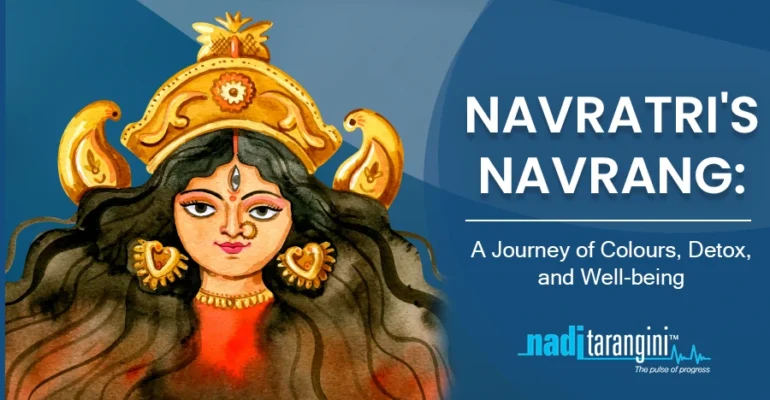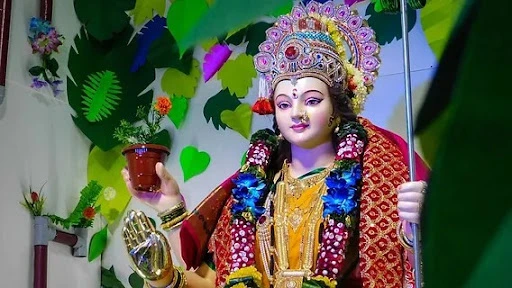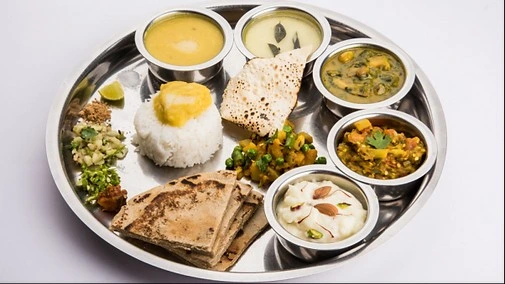Navratri’s Navrang: A Journey of Colours, Detox, and Well-being

Navratri’s Navrang: A Journey of Colours, Detox, and Well-being
The festival of Navratri is a vibrant and joyous celebration that holds a special place in the hearts of millions of people in India and worldwide. This nine-night festival, dedicated to the worship of the goddess Durga, is a religious observance and a cultural extravaganza that brings people together, celebrating life, music, dance, and, of course, a riot of colours. Navratri is a journey of Navrang, or nine colours, representing the diverse facets of life, detoxification of the mind and body, and pursuit of holistic well-being.
Navratri is the festival of Navdurgas that helps humans awaken from within. Navratri brings so many changes in weather as well as in daily routine. This mainly helps us to detox the human body.
Every cultural activity/festival has a scientific significance that positively impacts our mind, body, and soul.
For example:
Makar Sankranti | Chaitra Navratri | Shardiya Navratri
Shardiya Navratri:
This Navratri festival is celebrated in Sharad Ritu, and the duration of the festival is nine days. Many people do fasts for 9 days and eat particular foods only. Even wear certain colour clothes according to the day.

According to Ayurveda in Sharad Rutu Pitta is provoked as Agni (digestive fire) is mand (low) and may lead to various disorders of the digestive system like Acidity, Indigestion, Nausea, Skin allergies, etc. The body needs detoxification to eliminate the toxins accumulated in the body. However, the fast should not be excessive as it may cause deterioration of body tissues( Dhatu Kshaya).
Fasting is one of the ways to detoxify the body. Fast is of 9-day duration and could be of different types such as

Dry Fast (No Food – No Water)
Fasting on Water
Fasting on Fruits
Fasting on Liquids (Herbal Drinks)
Fasting from Grains
Fasting on Sugar and Salt
Intermittent Fasting
Circadian rhythm fasting [a time-restricted feeding (TRF) in which a person eats all of their food across a span of hours in the earlier part of the day].
According to Nutritional Science aspects, Fasting is one of the ways to detox, rejuvenate, and energize the body. Navratri food recipes are nutritious, Gluten-free, high in fiber, and low in fats. This kind of fasting provides good hydration, and high vitamins, and minerals. Such fasting imparts self-discipline as we develop healthy habits and reduce mindless eating.
This Navratri fasting is not only useful in detoxification of the body but also useful in various disorders like PCOS, Hypothyroidism, high cholesterol, Obesity, etc.
Navrang colours and their sequence are different every year. Below is the list of this year’s colours and their sequence is as follows:
Day 1 (Colour – Orange):
Pumpkin, Orange, Papaya, Carrot, Apricot.
Day 2 (Colour – White):
White colour foodstuffs are Milk, Curd, Buttermilk, Makhana, Cashew, and Varai (Kodo Millet).
Day 3 (Colour – Red):
Red colour foods are Apple, Strawberry, Watermelon, Pomegranate, Plum, Mulberry, and Raspberries.
Day 4 (Colour – Royal Blue):
Blueberry, Cowpea Flower infused Water.
Day 5 (Colour – Yellow):
Banana, Sweet Lime, Lemon, Sweet Potato, Potato.
Day 6 (Colour – Green):
Bhindi, Lauki, Cucumber, Mint, Green Grapes, Star fruit, Amla.
Day 7 (Colour – Grey):
Singhara Flour, Sunflower Seeds, Chia Seeds, and Dragon fruit.
Day 8 (Colour – Purple):
Jamun, Blackberry, Cranberry
Day 9 (Colour – Peacock Green):
Pista, Guava, Green Grapes.
People celebrate Navratri by doing Pooja, Fasting, Rangoli, and floral decoration at their places, Chanting Vedic Mantras of Goddesses, and wearing particular colour clothes on particular days. This shows unity and brings us closer to nature as we are a part of this nature.

Diversity is the main characteristic of Nature, and humans should adopt this characteristic in their daily routine by eating various colours of food in their diet. Nature has an ample collection of colours, which are due to different types of pigments. These natural entities have antioxidant activity which is helpful in the aging process and chronic disorders.
Navrang of Navratri (Nine Colours) enhances the physical beauty of the person as well as could make the mind and soul healthy through eating Navrang colour foods available in nature.
We recommend such innovative, Nutritious, Local but Low-cal fast recipes for Navratri through our reports using the device Nadi Tarangini.
Do visit our website www.naditarangini.com and follow us on our social media handles to know more about which recipes to consume to stay healthy as per your Prakruti & Vikruti changes.
Authors –
Mrs. Archana Patil (Wellness Coach – Nutrition)
Vaidya Shilpa Jamdarkhana (Wellness Coach – Ayurveda)

